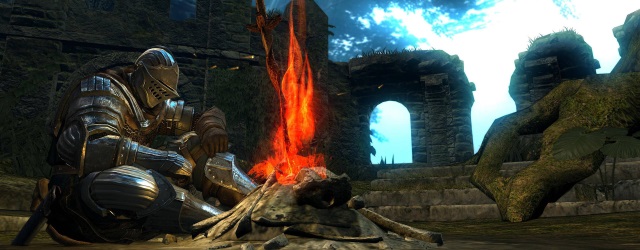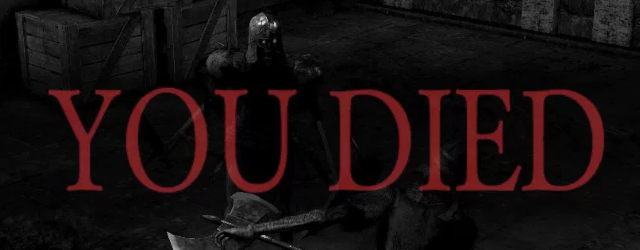
Ah, Dark Souls. There’s no forgetting your first time. In my case my first time was very brief; I bounced off it almost immediately. A while later I tried again and got a little further, and then gave up in the face of an interface that seemed intentionally designed to be as opaque and frustrating as possible. Later still I read a couple of guides, watched some videos, learned to avoid the forums and managed to push my way through to the end.
These days I can’t claim to have mastered the game, only the truly crazy can say that, but I KNOW the game enough to pick it up and try new builds or new challenges to relax.
Anyway, this guide. In a nutshell, it hopes to be a spoiler-free, not-at-all in-depth compilation of things I wish I’d known when starting out, specifically aimed at a first-time player So, onwards Chosen Undead…
What’s the best build for a new player?
A very common question, and the answer is almost always given as “whatever you like, you can finish the game with any build.” Which is such bullshit. Yes, it’s technically true that you can win with any stats, any weapon, any armour, any style, but a successful first playthrough is almost certainly going to fall into one of a handful of builds. Hopefully this guide will help you find a starter build that works for you without being too prescriptive.
What stats should I have then?
There are eight stats you can increase when levelling up. Let’s go through them:
- Vitality: Your health. You’ll want lots of this. Decreasing return on investment after it hits 30, negligible after 50.
- Attunement: Raises the number of spells you can have assigned at once. Realistically for a first run you’ll either ignore it or bump it to 10 so you can have one spell (like a heal)
- Endurance: Increases your stamina and your equip load (more on that in a moment). You’ll want a lot of this too. Stamina gains stop at 40.
- Strength/Dexterity: Primarily used to meet requirements for weapons/shields and increase damage output
- Resistance: Ignore this, it’s almost comically pointless.
- Intelligence: Use sorceries and improve their effectiveness
- Faith: Like intelligence but for miracles
TLDR?
Vitality to keep you alive, endurance to keep you moving, strength/dexterity to meet the requirements of your weapon of choice, then finally pump strength/dex to improve your damage output.
You mentioned equip load?
In a moment. There are two ways of avoiding taking damage in Dark Souls. The first is dodging and rolling. If you don’t get hit you don’t take damage. When you roll you get a brief window of invincibility.
First major thing I wish I’d known: Roll through attacks, not away from them. Counter-intuitive, but this isn’t martial arts, it’s a video game. You’re briefly invincible when you roll so if you go through the enemy’s attack it reduces the time you’re in contact. Roll with the attack and you’re just following the weapon’s hitbox and giving it more chance to connect.
That said, rolling takes practice, and a LOT of practice to make it viable as your main way of avoiding damage. So the second method is your armour and shields. Taking a hit on your shield absorbs some or all of the damage. Anything that gets through your shield (or you don’t block) then gets reduced by your armour. The heavier your armour the more it’s reduced.
But equip load?
There’s a necessary trade-off between dodging and tanking, and that’s your equip load.
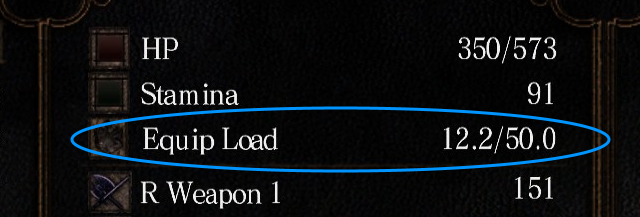
The more you’re carrying (not in your inventory, that’s unlimited, just what you’re actively wearing/wielding), the higher your equip load. The higher your equip load the less mobile you are. As your equip load decreases you roll faster and get to your feet faster. You essentially get the same window of invincibility but the slower you roll the longer you’re vulnerable after that window ends.
This is actually broken into discrete states:
- Equip load of 0-25%: Fast roll. You roll quickly and get to your feet quickly. You’re generally got to sacrifice armour to do this so not really a goal for a first playthrough as even with high vitality it’s not going to take many hits to kill you.
- 25-50%: Mid-roll. What you’ll get with a chunky weapon and decent armour. This is the sweet spot for a first playthrough for the simple reason that some bosses are near impossible to tank and this level of mobility is vital
- 50-100%: Slow roll. Rolling really isn’t going to be a thing, and you’re relying on armour and shield to keep you alive. Some bosses are going to eat you alive.
- More than 100%: No rolling, no running. You’ve made bad life choices.
So… mid roll?
Pretty much. A solid middle ground for a first playthrough. A knight will slow roll with his starting equipment, so either take some off, find some lighter armour, or boost your endurance.
I’ve heard about poise?
Poise is something heavier armour gives you – the knight’s set does, as does some of the armour dropped by the hollows in the Undead Burg. Essentially it lets you take hits without being interrupted. Without poise if you swing at an enemy and they hit you first it’ll probably break your attack. With poise there’s a chance you’ll take the damage but get to finish your attack anyway (known as “poising through it”; using it as a combat technique is “poise tanking”). Generally speaking, the chunkier your armour the more you can ignore what the enemies are doing and just mash them to death.
OK, less defence, more whacking. What weapon should I use?
Here’s where you’ll usually get the irritating “they’re all viable, whatever you enjoy” response. It’s bullshit here too. There are weapons that are objectively better for a new player than others. The main thing is – the longer the weapon the further away the fighting happens. If you don’t want an outright recommendation, skip to the next paragraph. OK? You’re sure. Right. The halberd. Fairly early game and will carry you to the end. It’s long, it’s got a good move set, it’s relatively light, it’s pretty fast and does very good damage. Failing that, the claymore or bastard sword, for similar reasons.
What should I know about weapons?
Weapons have stat requirements, almost always strength and/or dexterity. Bigger, heavier-hitting weapons want more strength (and weigh more), while smaller faster weapons want more dexterity.
Let’s have a look at a weapon in more detail:
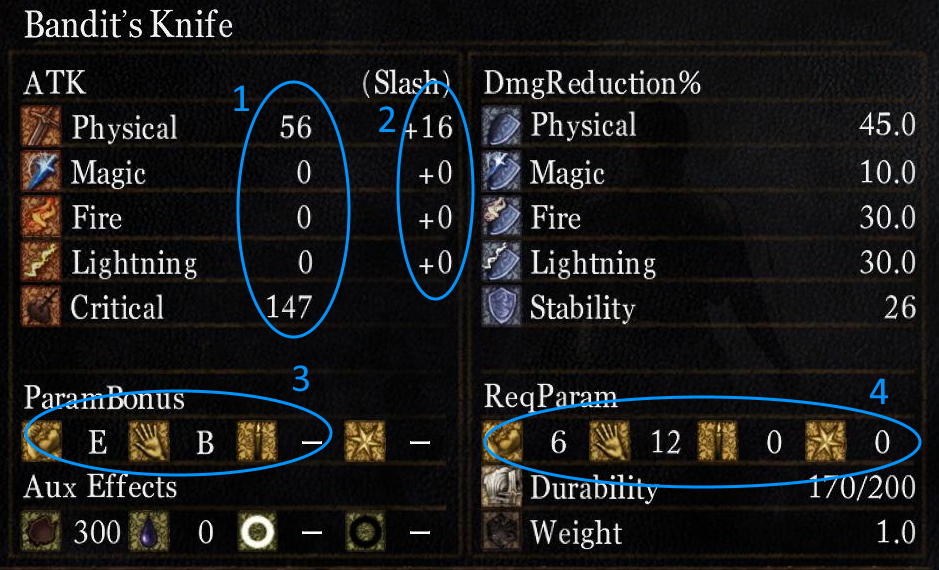
For reference, this is the starting dagger of the bandit class. Very fast, but low damage.
- Base damage. Most weapons do straight physical damage, some have additional types of damage too. Critical refers to the bonus you get for parries and backstabs. This dagger is doing a relatively low amount of damage.
- Additional damage. Most weapons get bonuses from your stats. This shows how much that bonus is. The dagger is getting almost 25% extra damage here.
- Scaling. The degree to which your stats contribute to the damage. Ranges from E to A, with S in exceptional cases. The dagger gets a tiny bonus from strength and a decent bonus from dexterity.
- Required stats. You must be at least this tall to use this ride.
How do I make my weapons do more damage?
Two ways. You can increase the relevant stats, or upgrade them at a blacksmith (minor spoiler there I guess, but it’s a fantasy RPG, of course there are blacksmiths).
Now, here are a whole bunch of things about weapons I WISH I’D KNOWN:
First, DPS is complicated. You’d think that two weapons, one which does half the damage but attacks twice as fast would have the same damage output, but they don’t. Damage depends on the disparity between your weapon’s damage and your enemy’s defence, and it’s not linear. One hit that greatly exceeds your enemy’s defence will likely do more damage than two hits that about matches it, and definitely more than several hits that are way under the defence. This is mostly not noticeable against your average mobs, but can be a huge issue against bosses and heavily armoured mobs.
Second, upgrading is WAY more effective than levelling to increase your damage output. Therefore I’d recommend increasing your strength/dexterity just enough to meet the requirements of your weapon of choice, and focus on vitality and endurance. Besides, see the next section on elemental damage.
Elemental damage?
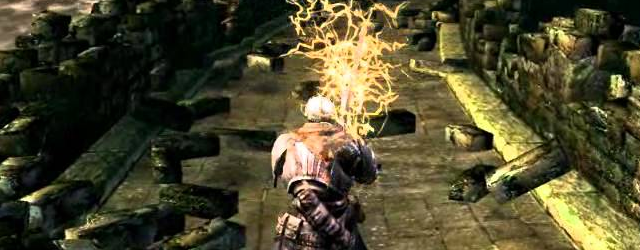
As you progress through the game you get the option to switch from pure physical to part physical part elemental (e.g. lightning). This has pros and cons.
Pros:
- Switching your weapon to lightning or fire removes the stat scaling; there is literally zero point in pumping strength or dexterity once you’ve done this, meaning you can focus on vitality and endurance.
- You’ll WRECK most mobs
- Some bosses are very weak to certain types of damage
Cons:
- “Split damage”. Whenever you make a hit you’re essentially making a separate attack for each damage type so you’ll suffer from the DPS complications I mentioned above
- Some bosses are REALLY resistant to certain types of damage.
- It’s more expensive. Upgrade materials are rare and more costly.
For a first playthrough I’d recommend having a pure physical weapon simply because it’s more consistent and you’ll usually end up doing more damage in the long run. It’s worth keeping a backup weapon on hand though with elemental damage to give you more situational flexibility.
Another piece of direct advice coming up. Skip to the next section if you’d rather not hear something too specific. Ready? Make something Divine when you get the chance. Divine weapons scale with faith so it’ll do pretty poor damage but there’s a section of the game where you’ll appreciate having something that does divine damage on hand. I’ll not say where, hopefully you’ll know it when you see it…
Anything I should know about shields?
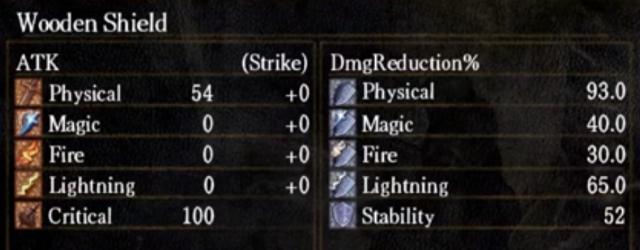
This is the information for a shield. If it looks very similar to the one for a weapon that’s because it is. Weapons are shields and shields are weapons. This time you’ll be looking at the right hand side – damage reduction. This is the percentage by each type of damage will be reduced. So if you have a shield with 50% fire reduction, then successfully blocking a fireball will reduce the damage you (and your armour) take by half. Ideally you’ll want a shield that does 100% physical reduction otherwise every single hit is going to chip away at your health.
Parrying
Small and medium shields can parry. As a rule of thumb, any humanoid enemy hitting you with a recognisable weapon can be parried. Timing is everything and takes a LOT of practice to get even vaguely reliable. Honestly, you can go your whole first playthrough and not parry a thing. That said, if you do take the time to practice it can make big chunks of the game significantly easier. To do it, watch the enemy’s weapon hand. As soon as the hand starts towards you, hit L2 or left trigger (I’m assuming you’re using a controller because you don’t hate yourself). You’ll know when you successfully parry because a) you don’t get hit and b) there’s a really satisfying sound. Wait a split second and then hit R1 to riposte for bonus damage. There’s no silver bullet to learning to parry, it’s practice, perseverance and muscle-memory. Whether you want to spend the time in your first playthrough is pure personal preference.
Note that the largest shields don’t parry; L2 is a bash instead.
Stability
When you block a hit with your shield your stamina is reduced. When your stamina runs out you can’t block until you let some regenerate. IMPORTANT: when you’re holding your shield up your stamina recovers much more slowly, so get in the habit of only raising it when you need to. After taking some hits try to back off and let your stamina recover.
Anyway, stability affects how much a blow drains your stamina. Higher stability, less stamina loss. The biggest shields let you turtle up almost indefinitely, while smaller shields need you to manage your stamina more carefully.
Any general advice?
Don’t forget to use target lock on. Click the right thumbstick to lock on, click again to unlock. It might seem obvious but if you missed it, well, you’ll kick yourself when you find out about it. Locking on means you’re always facing your target, always lined up for the block, you have a more clear idea of which way to roll if you need to, and your attacks are MUCH more likely to land.
Explore. Dark Souls is famous for it’s twisting level design. Shortcuts and loopbacks and connections are everywhere. Loot isn’t randomized and is often relevant to the area it’s found in (with some trollish exceptions…). BUT! Once you’ve cleared an area you’ll want to learn to start avoiding mobs and just running around. This is a skill unto itself but unlike parrying it’s absolutely worth learning – and is why you should be mid-rolling for that extra manoeuvrability. And when you’re doing that run from the bonfire to the boss for the fiftieth time, yeah, you’ll be glad you don’t have to stop to fight everything along the way. For your first playthrough don’t expect to be able to leap gazelle-like through everything the whole way, but every group of mobs you can skip is a few seconds of time saved.
Don’t be afraid to look at a map online. Some bonfires and shortcuts are well hidden and if you don’t find them you’re going to have a measurably worse experience.
TIP! Don’t panic-roll. You roll to avoid a hit, not to get clear. Running is faster and uses less stamina. Ideally you only roll if something’s trying to hit you.
ANOTHER TIP! Learn to kick. Everyone remembers those fun moments facing off against hollow spearmen turtling behind their shields, the endless waiting as they wander back and forth, back and forth. One kick breaks and hey presto, broken guard.
Bosses
Yeah. Yeah. Bosses. You’re going to hate them. They’re going to make you hate the game. The designers. Everyone who ever recommended you play the game. Your controller. They’re hard. They’re unfair. I’ve finished the game many times and there are still some bosses where I have to pause and take a deep breath before going through that fog gate. There are strategies for every boss, but I’m not going to tell you what they are, because spoilers. But there are general tips you should know:
Getting to the bosses: They’re going to kill you a lot so it’s worth learning the run from the bonfire. It’s an intention and absolutely obnoxious design decision to put the bonfires a frustrating distance from the bosses, so every death is punished just that little extra. It doesn’t get better in the later games either, so it’s definitely intentional. I will say though, there’s a mid-game boss that’s infamous, and the bonfire run is AWFUL. There’s a slightly cheeky shortcut though – ask and ye shall receive.
Learning the fights: Unless you get really lucky or visit them out of the expected order (actually surprisingly easy as Dark Souls is fairly open between its big plot-doors), you aren’t going to kill a boss on your first try. So the best thing to do is not attack, keep your shield ready, and watch what they do. Each boss only has a finite set of attacks and actions, so it won’t take long before you’ve seen everything they can throw at you. What they chose to do is often based on your range and position relative to them, so you won’t see everything by keeping your distance, but as long as you’re cautious and keep moving you’ll survive a surprising amount of time.
The important thing to learn is the “tells”. Bosses telegraph their actions, some subtly, some massively. If a specific attack is giving you grief (and one boss has one in particular that will, trust me…) stop focussing on doing damage and WATCH the boss. It’ll take time and deaths, but in general the more evil an attack is the more clearly it’s telegraphed.
I know, at first this advice can seem unlikely, not for a first time player. The boss is huge, it’s in your face, half the time it’s killing you in one hit, and I expect you to look at the edge of the screen to see what it’s hand’s doing? Yeah, right. But it’s invaluable.
Also, don’t underestimate how much damage you can tank with a half-decent shield. The bosses are immense and wield weapons the side of cars, but if you’re at full stamina and take a hit to the shield, it might flatten you but you probably won’t actually take much damage, and early bosses in particular leave a generous gap between attacks for you to get to your feet and start moving again.
Actually hitting them: Spamming attacks on bosses will get you killed. Almost always. Even veterans fall prey to this – the boss has hardly any health left, just a couple more hits, YOLO, out of stamina and dead. Patience is the key. One hit at a time. Avoid/block an attack, hit back. Move. Repeat. Generally you’ll want to keep behind them, especially the bigger and slower ones.
Weapons: The larger the better, for bosses. Fast, low-damage weapons will barely scrape some bosses’ hides. As you’re generally going to be getting in a hit here, a hit there, you won’t so much be worrying about speed and stamina usage, you just want each hit to really count.
Be patient. Not just in terms of how many attempts it will take. Be patient in the fight itself. Wait for opportunities. Take your time. If you have a chance to hit or heal, it’s almost always worth healing. Getting greedy on the last hit will get you killed.
And finally, if a boss is really giving you some grief, consider leaving it for later. Level up a bit, get some more health (especially in the early game), switch out or upgrade your weapon (more for mid game), find better equipment. Sometimes, honestly, just walking away from a boss and coming back when you’ve unwound a bit can make all the difference.
Summoning help
if you reverse hollowing at a bonfire, you get the option of summoning help. If you’re online this can be other players – and generally these other players will be good enough to solo a boss for you.
If you’re not online then there are still NPCs who can be summoned for some bosses. Generally their purpose will be to serve as a distraction – there’s only one boss where the available NPC will out-damage you. In fact, as each summon increases the boss’s health, it can sometimes be counter-productive to summon. Still, if you’re getting overwhelmed by a boss then a warrior at your side to draw some aggro can give you the breathing space to heal up and reposition. As a rule, the more unfair the boss seems, the more useful a summoned NPC will be.
I can already hear hordes of Dark Souls veterans frothing that it’s cheating, that it’s not a “pure” experience, that you haven’t really beaten the game if you summoned. And I disagree. Summoning is a mechanic of the game, just like Estus or parrying. Yes, a “no summons” playthrough is definitely a thing, but it’s no more the “real” way to play the game than a no healing run. Don’t feel shame in summoning. You can always play again and kill the bosses by yourself with the benefit of experience.
I have some random questions
Bring it on.
I clicked “pillage corpse” but I don’t want to pick up yet another broken straight sword. how do I cancel?
You can’t. Sorry. Just drop it or ignore it.
What about selling it?
There are merchants, but they don’t buy. There is a way to sell, sort of, but that’s much later in the game.
How do I upgrade my equipment?
Find a blacksmith, find or buy some upgrade materials (titanite of various kinds, starting at “titanite shards”, all the way up to chunks and slabs – the different types do different “tiers” of upgrade), and they can do it for you
I found a blacksmith. What’s the difference between modifying and reinforcing my weapon?
Reinforcing is adding a level to your weapon, e.g. from a basic longsword to longsword +1, etc. Modifying is taking the weapon to the next tier of upgrades, or to another path, e.g. fire.
I’ve got a bow, how do I aim?
Either lock on, or use L1 to enter aiming mode. Use up/down on the d-pad to zoom in/out.
I’ve made it to Firelink Shrine and the next boss is making me want to stop playing
Yeah, that’ll happen. This section is going to go into some solid specifics to get a new player into the game. Skip it if that’s not what you want from me.
From Firelink Shrine you can go in three directions: through the graveyard, down the lift and up into the Undead Burg. The graveyard holds some souls, a shield with good magic resistance and a very chunky weapon. You’ll get murdered running through it but it can be a good place to do early suicide runs to pick up some loot. Don’t go past the graveyard until you really, really know what you’re doing.
Down the lift is “New Londo Ruins”. Across the bridge lies death, but also a good opportunity for a suicide run to pick up a Firekeeper Souls. Give it to the Firekeeper at the shrine to make your Estus flask restore more health. More importantly, down a hard-to-see set of stairs is the game’s first blacksmith. He doesn’t sell much but if you’ve picked up any titanite shards on your travels through the Burg he can upgrade your weapons and shields for you – this can give you some much-needed extra clobbering power against the Burg boss.
The Undead Burg is your primary area and the hollow soldiers there drop a decent range of weaponry – the battle axe especially will carry you to the mid game. The armour they drop is pretty poor, but for some reason their waistcloths (pants) are light and have poise, making them a good replacement for the much heavier knight’s leggings.
You might miss him, but there’s a merchant in the Undead Burg who sells a lot of good weapons and armour, and a key you’ll definitely want to buy. He also sells the shortbow, which has the lowest dexterity requirement of all bows and is useful to keep on hand.
…and the area boss?
Once you’ve gone through the fog door, look immediately right. There’s a ladder. Go up and clear out the archers hiding up there – you don’t need them peppering you during the fight. Go down, trigger the boss. Keep your distance, nudge close to bait an attack, dodge back, hit him once while he recovers and get back again. If he’s pushed you to the end of the bridge, scoot past him (or under him) and carry on in the other direction. One hit at a time. Heal rather than attack if you need to. Keep your shield up while your stamina is full, a knight can actually soak a single hit pretty well behind their starting shield.
…is there… an easier way?
Yes. And repeat after me: there’s no such thing as cheese in Dark Souls. Just alive bosses and dead bosses. Make sure you’re at least mid-rolling, preferably fast rolling so you can run faster. Trigger the boss and immediately run back to the ladder. Climb up, turn around and plunge attack. You’ve got a few seconds leeway, then he’ll jump up and join you – make sure you’ve jumped on him before that happens. Once down, immediately run to the far end of the bridge. Bait an attack and run past him while he recovers. Climb up the ladder, plunge attack, repeat until victory is yours. With a half decent weapon three plunge attacks should be enough.
That’s a lot of text. TLDR?
- Stats: Lots of vitality and endurance, and enough strength/dexterity for the weapon you want to use. Once you’re happy with vitality and endurance, then start pumping your damage dealing stats
- Weapon: Keep it pure physical, it’s more reliable and less complicated. Have a fire or lightning weapon on hand if you like, for close encounters.
- Weapon again: Avoid fast and small – it makes bosses significantly harder. Also avoid too slow – too much vulnerability before and after hits.
- Armour: As chunky as you can while still being able to mid-roll (i.e. equip load below 50%)
- Shield: Something with 100% physical damage reduction and as high stability as you can.
- Magic: Not on your first playthrough
- Be patient
- No, be more patient than that
- The rush people talk about when you beat some bosses for the first time? It’s totally real
- Don’t be ashamed to get help, look in wikis, watch videos, or summon for boss fights
That last one is, to me, the most important. Th forums are full of people belittling others for not having a “pure” experience. Screw that. If the alternative is stopping playing then obviously do some research or get some help. It’s a game for crying out loud, not a rite of passage. In my first successful playthrough I used wikis, videos, walkthroughs, summons, cheese, everything. And now it’s one of my favourite games. I’ve racked up hundreds of hours in it. I play it to relax. My children love watching me play it. I just wrote a four thousand word guide on it. Does that sound like someone who had their Dark Souls experience ruined by summing
Dark Souls is an amazingly fun and satisfying game, but it hides so much of it behind an impenetrable interface, opaque mechanics, a frequently toxic community, and some of the most frustrating and obnoxious design decisions. But the fun is in there. Hopefully this guide will go some way to helping you find it.
Praise the sun
